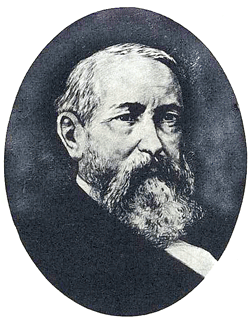Chief Copy Editor
In 1889, not long after Thomas Edison invented the first commercially viable incandescent lamp in 1879, permanent electric lights were installed in the White House by the Edison General Electric Company. Edison’s lighting was powered by direct current (dc), which he promoted as being safer than the competition: alternating currect (ac).

President Benjamin Harrison, 23rd President of the United States, 1889 to 1893
Nevertheless, President Benjamin Harrison received a shock from a dc current light switch, after which his family feared touching the switches. In fact, First Lady Caroline Harrison never used electric lights. Servants were often made to turn the lights on and off for the Harrison family, who were so afraid to use the switches that they often went to bed with all the lights still on.
Despite the First Family’s fear, electricity was growing in popularity, and the chief question was how it was to be distributed. Edison’s dc distribution system consisted of generating plants feeding heavy, low-resistance distribution conductors, with customer loads (mostly lighting and dc motors) tapped off them. The system operated at the same voltage level throughout; for example, 100-V lamps at the customer’s location would be connected to a generator supplying 110 V, to allow for some voltage drop in the wires between the generator and load. The voltage level was chosen for convenience in lamp manufacture, and at the time it was thought that 100 V was not likely to present a severe electric shock hazard, President Harrison’s experience notwithstanding. At least it wasn’t fatal.
The ac system developed by George Westinghouse and Nikola Tesla in 1887 was different. It used a transformer between the (relatively) high-voltage distribution system and the customer loads. The transformer allowed power to be transmitted at much higher voltages, say, 10 times that of the loads. For a given quantity of power transmitted, the wire diameter would be inversely proportional to the voltage used. Alternatively, the allowable length of a circuit, given a wire size and allowable voltage drop, would increase approximately as the square of the distribution voltage. These characteristics meant that ac required fewer , though larger, generating plants to serve the load in a given area. Large loads, such as industrial motors or converters for electric railway power, could be served by the same distribution network that fed lighting, by using a transformer with a suitable secondary voltage.
By the time the Westinghouse ac system was introduced, Edison’s dc had already become the de facto standard for the United States — dc worked well with incandescent lamps, which were the principal load of the day, and with motors — and Edison did not want to lose all his patent royalties, so he waged a campaign against ac. Edison’s campaign to discourage the use of ac included spreading disinformation on fatal ac accidents, publicly killing animals, and lobbying state legislatures to not allow ac current to be used. Edison directed his technicians to preside over several ac-driven killings of animals, primarily stray cats and dogs, but also unwanted cattle and horses. Acting on these directives, the technicians were to demonstrate to the press that alternating current was more dangerous than Edison’s system of direct current.
Edison opposed capital punishment, but his desire to disparage the system of alternating current led to the invention of the electric chair. Harold P. Brown, who was being secretly paid by Edison, built the first electric chair, in 1890, for the state of New York to promote the idea that ac was deadlier than dc.
Edison also tried to popularize the term for being electrocuted as being “Westinghoused.” (Years after dc had lost the “war of the currents,” in 1902, his film crew made a movie of the electrocution with high-voltage ac, supervised by Edison employees, of Topsy, a Coney Island circus elephant which had recently killed three men.)
Eventually, Edison and his dc electrical system lost. The Westinghouse ac system became the American standard and is still in use today. “Westinghouse” never became a synonym for electrocution. And today, the President sleeps, like the rest of us, with the lights off.
Sources:
History of electric lights: http://inventors.about.com/od/lstartinventions/a/lighting_2.htm
President Harrison’s fear of electricity: http://www.inventhelp.com/Inventions-and-the-Presidency.asp
“War of Currents”: http://en.wikipedia.org/wiki/War_of_Currents
Video of an elephant electrocution: http://en.wikipedia.org/wiki/Topsy_(elephant)
Dc and ac: http://cenvironment.blogspot.com/2010/03/electricity-direct-current-ac.html
Summary of the battle between Edison (dc current) and Westinghouse (ac current): http://www.nku.edu/~turney/prclass/readings/crisis_execution.html
Fear of electricity today: http://www.changethatsrightnow.com/fear-of-electricity
The images of the Presidents, from Washington to Eisenhower, in this series are from a little book I got from my mom when I was less than 10 years old. Simply titled Presidents of the United States , this book began my interest in the Presidents. I think it came from an insurance company, but I can't find a publisher listed in its pages. See http://www2.electronicproducts.com/How_I_got_interested_in_Presidential_history-article-fals_president_start_aug2012-html.aspx ■
Advertisement
Learn more about Electronic Products Magazine





